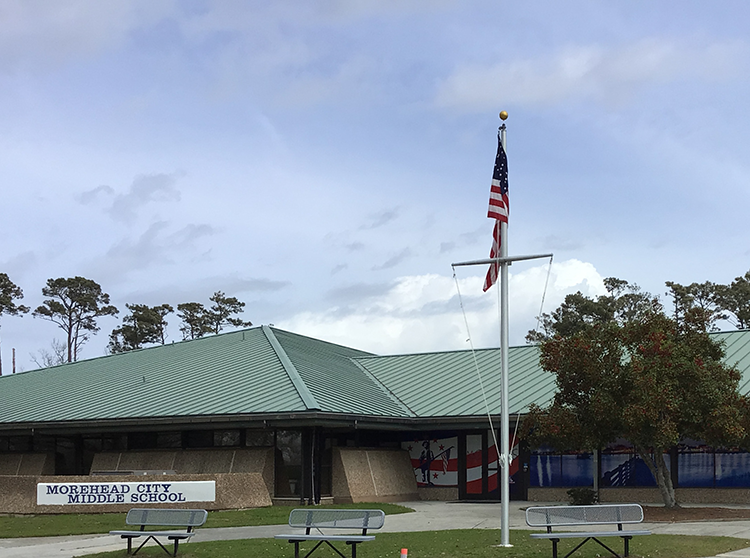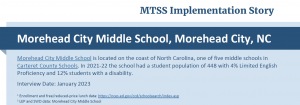Morehead City Middle School, Morehead City, NC
MTSS School Implementation Story

Morehead City Middle School
Morehead City Middle School is located on the coast of North Carolina, one of five middle schools in Carteret County Schools. In 2021-22 the school had a student population of 448 with 4% Limited English Proficiency and 12% students with a disability.
Interview Date: January 2023
1 Enrollment and free/reduced-price lunch data
2LEP and SWD data: Morehead City Middle School
Background and Catalyst
Morehead City Middle School’s district first rolled MTSS out in its elementary schools. The middle school had begun implementing MTSS the year before COVID-19 struck and already had in place a number of MTSS structures (e.g., an MTSS team with grade level representatives, a spreadsheet of all students for tracking data). The COVID-19 pandemic and turnover of school leadership combined to slow MTSS efforts for several years. In 2021-22, with a new assistant principal to lead the charge, the school decided to start over and rebuild its MTSS efforts from ground zero with the goal of taking it back to a more focused approach. Interviewees reflected on their thoughts at the time: “We’re going to do what we need to do, but we’re not going to overcomplicate it.”
The school began by deciding on what the new, simpler version of MTSS would look like, especially given that students were attending school on a hybrid schedule that year with only two days per week of in-person instruction. They started by screening all students using FastBridge, which revealed gaps in academic progress. After winter break, the school began implementing intervention groups during a dedicated “What I Need” (WIN) block that had been established in the master schedule. Since 2021, the school has continued to refine its use of this 45-minute period for intervention and focus on improving Tier 1 instruction. It is also working to integrate MTSS and school improvement.
The Present: What Does MTSS Look Like Now?
Leadership: Vision, Teams, Structures, and Processes
Currently, the school’s MTSS work is led by a team that includes the principal, assistant principal, school counselor, and a shared school psychologist. While teachers review and monitor the data for students in their homerooms, this core MTSS team examines all student data for the school—including the Fastbridge universal screener, end of grade scores, and classroom data. Each nine weeks, the team identifies students in need of support. These students are then discussed with grade level teacher teams during their weekly collaborative meetings and matched with the intervention support they need. For students with behavioral concerns, a student support team meeting including the school social worker, nurse, counselors, administrators, and a part-time behavior specialist may also be convened. This behaviorally-focused team looks at office discipline referrals, absences and how many times particular students go to the nurse, as those are all indicators of potential needs.
Student Supports
The school began its most recent approach to providing student supports within MTSS by working a 45-minute schoolwide intervention block called WIN time into the master schedule. At first, this period involved all students in the school, but students who did not need academic help were able to participate in fun club
activities like cooking or yoga club. Not only did the school have difficulty managing so many different activities, but it became apparent that students who were receiving intervention support perceived it as punishment compared to the activities their peers were able to do. The school then changed all WIN activities to involve all students in either reteaching, intervention, or enrichment. For example, elective, science, and social studies teachers lead physical education, art, and STEM activities. Some teachers also specialize in teaching study skills—which are critical for middle schoolers—during WIN time.
Tier 2 and 3 interventions in reading or math are provided in nine-week cycles. All teachers implementing Tier 2 or 3 interventions receive training in that intervention and all staff in the school are trained in the school’s progress monitoring system. At the end of each 9-week cycle, each student’s current teachers mark on the spreadsheet the student’s progress and adjustments to interventions are made as needed. The student may receive more or less intensive intervention or be discontinued from intervention they no longer need. Students are also added to or removed from the progress monitoring list as needed. Teacher feedback about student progress and any changes needed to intervention for particular students is requested and considered by the MTSS team.
The school district uses a standard protocol approach to intervention. That is, there are several options for Tier 3 reading interventions and one for math. If a student needs a Tier 3 behavior intervention, there is a standard school protocol for how to develop the intervention for that. Interviewees felt that having these protocols in place made it easier to ensure that students get what they need across teachers. The district has also worked to make the data and documentation used across its elementary schools consistent, which helps the middle school when receiving information about students from different feeder schools.
Impacts of MTSS on the School
Interviewees noted that one noticeable impact of the district’s overall MTSS implementation is that students entering middle school from the district’s elementary schools are less likely to be identified as needing Exceptional Children services (EC, also known as special education), as there are more intermediary intervention
options. The middle school also reports that EC referrals have gone down, which has coincided with a teacher mindset shift from assuming students who are performing below grade level might need EC services to a focus on what the student’s data shows and what support they have been provided. The use of progress monitoring data was reported to have also given classroom teachers more insight into the progress individual students are making.
The school also reported “tremendous growth” on the state end of grade exams, which is when interviewees say teachers started to realize MTSS is making a difference. Interviewees noted that a more intentional focus on analyzing student data has helped teachers identify and more accurately target specific skills to better support students. The school met its growth goals in 2021-22 for every student subgroup and attributes this success to aligning Tier 1 instruction and the supports students receive in Tiers 2 and 3, as well as the infusion of literacy into other content areas (through an increased focus on explicit vocabulary and morphology instruction and attention to cross-content note-taking strategies). “That’s the Tier 1 part of MTSS. You need every teacher to commit to a literacy focus across all subject areas.”
What Challenges Did the School Encounter with MTSS Implementation?
Staff Turnover and Time for Interventions
Turnover at the school leadership level proved to be a barrier to getting started with MTSS for this school. Multiple assistant principals led the charge in getting MTSS underway, but each time one left the school, the
school had to start over again with the new person. It takes time for MTSS to become integrated into school practices and sustainable; and turnover at the school leadership level can be a challenge. In addition to leadership and other turnover, interviewees described scheduling as a challenge. While the school was able to make time in the schedule for its WIN block, it required some creative efforts (e.g., it had to double as a resource block for students receiving EC services). Finding time for progress monitoring at the teacher level is another challenge the school faced. School MTSS leaders helped teachers find ways to structure their classes to facilitate progress monitoring and spread out the demands of progress monitoring.
Implementing Consistent Schoolwide Practices
Another challenge mentioned is ensuring that all students receive high quality core instruction across content areas and teachers. In this school, administrators set the tone by doing walkthroughs and fidelity checks, as well as providing individualized feedback to teachers. The school has prioritized consistent cross-content instructional practices and trains all teachers in Keys to Literacy. Teacher turnover means that ensuring all new teachers receive this professional development is an ongoing process. The school is also focusing on developing consistent schoolwide classroom management practices to ensure that expectations for student behavior are similar between teachers.
Advice for Other Schools
Keep the Approach to MTSS Simple
The interviewees described the importance of keeping a school’s MTSS vision simple and keeping the main goal in mind: “At the end of the day, give kids [the support] they need, track their data. If they’re making growth [keep going], right? If they’re not, change it. Do something different.” They felt that overcomplicating MTSS can make it “this big, scary thing,” when really the main idea is much more basic—to identify students who need support, provide that support, and make sure the support is working to help get students where they need to be. For this school, simplifications of MTSS processes involved changing the grade level meetings from being after school to being part of planning time once a week and using these meetings to focus on high-risk students. Data tracking and progress monitoring processes were also simplified.
Stay Focused on Tier 1 Instruction
This school suggested that other schools look critically at their Tier 1 instruction and work towards making sure that it is high quality, aligned, and consistent across classrooms, because, as they described it, intervention is not a substitute for poor core instruction. Interviewees expressed that having schoolwide instructional practices in place across content areas (e.g., two column notes, topic webs, intentional teaching of content-specific vocabulary and morphology) ultimately improves the academic skills of all students and decreases the need for intervention support.
“I think North Carolina moving towards MTSS and getting away from the discrepancy model really changed a lot of things for a lot of teachers. And I think it has benefited a lot of the kids.”
“We’ve built up MTSS—this big, convoluted, complex thing, and it doesn’t really need to be that… I think once we eliminated all the other fluff and individualized it for each student in our entire school, and made it very simple, it definitely has changed [things].”


This website was developed under a grant from the Department of Education through the Office of Program and Grantee Support Services (PGSS) within the Office of Elementary and Secondary Education (OESE), by the Region 6 Comprehensive Center (RC6) at the SERVE Center at UNC Greensboro under Award #S283B190055. This website contains resources that are provided for the reader’s convenience. These materials may contain the views and recommendations of various subject matter experts as well as hypertext links, contact addresses, and websites to information created and maintained by other public and private organizations. The U.S. Department of Education (ED) does not control or guarantee the accuracy, relevance, timeliness, or completeness of any outside information included in these materials. The views expressed herein do not necessarily represent the positions or policies of the U.S. Department of Education. No official endorsement by the U.S. Department of Education of any product, commodity, service, enterprise, curriculum, or program of instruction mentioned in this document is intended or should be inferred.
RC6 @ SERVE Center 5900 Summit Avenue, #201 Browns Summit, NC 27214
Copyright © 2020-2025




